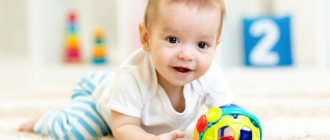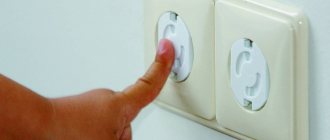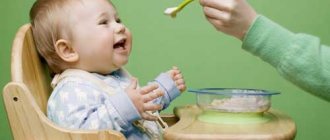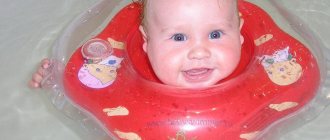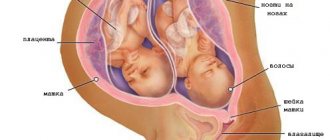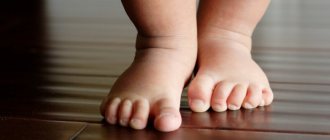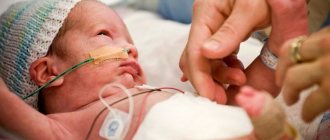A nine-month-old baby undergoes dramatic changes in appearance and development. He is very active, curious, and does not like to be left alone in his crib for a long time. The baby's favorite pastime is playing on the floor with her toys. Therefore, the mother has more and more free time, and her task is to monitor the baby and communicate with him.
At 9 months, the child’s skeletal and muscular systems are especially actively developing, as preparation for upright walking begins. When a child turns 9 months old, his development and nutrition changes somewhat.
What can a 9 month old baby do?
By nine months, the baby changes dramatically. Mommy no longer sees him as a clumsy fat man. A curious baby always asks to sit on the floor and demands communication. This is a very important period when the child’s body prepares for upright walking. Well, let's monitor the development and nutrition of a child at 9 months, his basic abilities.
By holding on to the support, the baby manages to stand and walk. He can crawl in different directions and climbs to heights on all fours. The child can easily sit up and lie down on his own. Holding onto a support, he can not only stand, but also jump. The baby can stand holding the parents' hand. He easily repeats the movements of adults: raising and lowering his arms, clapping his hands. What can a 9 month old baby do? By this age, he has developed many sensory, intellectual and social knowledge:
- Sensory-motor dexterity. If a child at this age is given a toy, he calmly picks it up. Can slowly bring it closer to itself and examine it. He manages to pick up small objects with one hand. Often plays with two toys at once. While crawling, he is able to hold an additional object in his hand. The baby claps his hands perfectly. Able to crawl backwards.
- Intellectual abilities. The 9-month-old baby loves interesting games where you need to repeat simple actions several times. He easily remembers the game he learned the day before. I especially like hiding behind my palms in the game “Where are you?” He is happy to show with his hands how big he is. The baby can fulfill simple requests: nod his head, wave his hand. The child easily repeats simple words after his parents: give, am, mom, dad. Often the baby develops a fear of space and heights.
- Social skills. A 9-month-old baby is very attached to his parents and loves to play next to them. He manages to copy the emotions and gestures of other people. He reacts to laughter with a smile, to crying with tears. Baby no longer plays with all the toys in a row; he chooses them carefully. At the request of the parents, he may sneeze or laugh. Sometimes the baby himself takes the initiative to start a new game. If mommy asks him to repeat something, he will do it with pleasure.
Developmental activities with a nine-month-old baby
Development of a child's physical fitness at 9 months
At 9 months, you should continue the gymnastics classes you started earlier, complicating the exercises as necessary. At this age, you can try to start doing bends, bends, squats - of course, all this is done with the support of an adult. Let your baby walk holding your hands. But most of the time during this period should be devoted to crawling. Moreover, it is easy for a child, and he is able to do it independently.
To make crawling more interesting, organize various obstacle courses, play with a ball and your favorite toys. Start learning how to put things in order. Let your child collect things scattered around the room with your help. Once he learns to put them in boxes, learn to sort them. For example, put cubes in one place and soft toys in another, try arranging things by color.
A very interesting toy for a child is a roll of toilet paper. Such a simple thing can cause real delight. In addition, while playing with it, the baby will actively crawl, develop tactile perception and fine motor skills, and study the properties of paper. Just give your baby a roll - most likely, he will figure out what he can do with it. If not, then show how fun it is to tear paper, roll it on the floor, and unwind it.
Drawing and modeling for children at 9 months
At 9 months you can start drawing. To do this, use crayons, wax pencils or finger paints. Make simple shapes from plasticine. Practice with your child and show him how to act. Be sure to use environmentally friendly products.
Objects on a string for a 9 month old baby
Playing with objects on a rope will be interesting and useful. The baby can move them around the floor, but this is not the only way to use them. Tie the toy to the crib partition. Let the child throw it away and then pull it back in. The game will help develop coordination, motor skills and logic.
Speech development classes for 9 month old children
Most likely, your baby cannot yet pronounce words on his own, but only repeats simple syllables. However, he has already formed some passive vocabulary. It is important to consolidate and expand it. Surely, you know the names of which objects are familiar to your baby. Lay them out in front of him and offer to take them one by one, then one, then the other. There may be mistakes the first time. Just correct the baby, and if he succeeds, don’t forget to praise him.
Read children's books with large, bright illustrations together. Constantly point with your finger and name what is depicted on them.
Development of coordination of children's movements at 9 months
Play hide and seek with your little one. Place the diaper over your head and then pull it off. And so on several times. Then offer the baby to hide and cover him with the diaper. Most likely, he will enjoy the game, and he will be able to pull off this cover himself. If not, then show how to do it. A prerequisite is that the child must enjoy the process. If he is scared or uninterested, then do not insist.
Teach your baby to undress. The simplest action is to take off your sock. Also try to remove the T-shirt not completely, leaving the neckline on the neck. Show the baby how to proceed next.
While bathing, teach your baby to wash himself. Fill your hands with water and wash your face. Let the baby try to repeat after you. If necessary, help him fold his arms correctly and make the movement. After water procedures, also use your example to show your child how to wipe his face with a towel.
For your activities to be as beneficial as possible, they must be enjoyable. And to save precious time, try to introduce an element of play into your daily life. Use available items and do household chores with your baby. Gradually and in a playful way, teach him to be independent and orderly.
Features of mental development
The 9-month-old miracle is constantly exploring space. He is interested in everything: how doors open and close, why the furniture stands still. A lot of new things are emerging in the mental development and nutrition of a 9-month-old child. During a conversation, the baby changes his intonation and reacts to his name. If you call him, he immediately turns around with a smile on his face. Emotions at this age gain certainty. The baby expresses joy, resentment, anger, malice.
It is very interesting to watch how a child points his finger at the objects he needs and asks him to get them. Often he wants to climb into a cabinet or refrigerator. Pockets are his favorite place to find something. He can show agreement and denial by nodding his head. Dressing a 9-month-old baby is becoming increasingly easier: he puts his arms into the sleeves, guides his leg into his trouser leg, and takes off his hat. The child determines where the adults are by their voice or rustling sound. He still doesn’t know how to handle toys correctly; he throws or knocks them.
Purpose and purpose of educational games from 9 months of age
Games with an 8 month old baby
Any play-based activity for children nine months and older has its own rules and ultimate goal. To build a pyramid yourself, to find the right shape or color, means learning to follow certain guidelines or rules. Child psychologists strongly recommend including educational games in your waking routine every day. Parents of a growing child should devote just enough time to play so that there are no whims or fatigue. Developing perseverance from early childhood will help your child overcome learning difficulties in the future. It is recommended to make a plan so that the baby can gradually develop.
Speech development
By 9 months the baby can connect a word and a certain object or action. Understanding the dependence of concepts brings us closer to the beginning of a dialogue between an adult and a toddler. He accepts simple requests. All syllables from the baby’s mouth must be supported. The first conscious attempts to communicate cannot be ignored. Maximum voicing of any action, parental commentary on any event will allow the child to quickly master conversational skills. Clear and competent speech from an adult will help your child develop his or her speech faster.
If, when looking at pictures from a book, contact occurs, the child begins to imitate adults, tries to pronounce individual syllables, the sounds “woof”, “meow”, “yum” and others. The educational game “Teremok” improves attention, articulatory apparatus, and emotional manifestations. To play you need to have:
- toy house;
- toys;
- cubes or objects;
- small dolls.
Having hidden all the prepared accessories in the house, the adult must take turns taking out the objects, making sure to voice each one. The child needs to be stimulated. He must learn the lesson, repeat the sounds after the adult. If you prepare for this game, you can recite a poem about objects from the Teremok. A developed baby should hear correct speech; there is no need to deliberately lisp or distort the pronunciation of words.
Physical development
As the baby's mobility increases, he needs gymnastic exercises in a playful way. It is better to combine games with a 9 month old baby with a show on a large toy animal, a doll. Consistently doing exercises for the doll and the child, the adult will enhance the physical effect with a visual comparison:
- movements of bending and extension of the baby’s arms in a sitting position;
- now it’s the turn of the legs, also perform sequentially, lying down, one at a time and together;
- turn the handles in a circular motion (the child is sitting);
- tilting the child's torso in different directions while sitting;
- take turns tilting the body, having previously pressed the child’s back to the adult; for the exercise you need to press the toddler’s knees.
Leg flexion and extension
To teach a child better, the following conditions must be met:
- the space for games and activities must ensure the complete safety of the child;
- When showing a game with objects, you need to voice each action, naming the color, the nature of the movement (“the blue ball is jumping up and down”);
- all games with objects should be joint - passing a cube or a toy to the child;
- You should teach your child to rejoice after an action - “Where did the ball go”, “Let’s look for the bunny”, “We need to catch up with the car”.
Important! During the exercises, you need to carefully monitor your reaction and mood. If you liked the exercises, the baby will demand to continue. Children's whims or crying should not be allowed.
Crawling training
Games to develop sensorimotor skills
Games with a child at 9 months, aimed at improving motor skills, are possible thanks to the leap at this age. A growing baby learns to take objects not by grasping them, but by raking movements of his fingers. Usually he carefully touches it with his index finger, then with two or three he takes out a light object. Can move several (up to 3) toys at the same time. The faster sensorimotor skills develop, the easier the child will begin to speak syllables and practice in the future.
sorting through toys
Dr. Komarovsky advises starting games with paints, dough or plasticine from an early age. If you show your child how you can leave marks on a piece of paper with your fingers, he will become interested in creativity.
Important! For games with babies to develop motor skills at 9 months, you need to use non-toxic paints or crayons.
Similar games can be transferred to the bathroom. Let’s say you use fresh strawberries to paint the tiles on the wall or the body of a toddler. Then wash off all traces under a warm shower. Using a piece of salt dough, show how to stick various objects into it: beans, pebbles, pasta. Then, together or independently, “search” and pick it out of the cake. A good option for a game for motor skills is to give your baby a thin string with a toy attached to his hands. He will be happy to pull it along the floor.
Games to develop coordination
Starting from infancy and up to 16-18 years, while the skeletal frame grows, orientation in space is formed. The cerebellum is responsible for these processes, its development mirrors the skills: crawling, walking and the first steps. The vestibular apparatus helps a person move confidently, without a “wobbly gait.” What to do with the baby?
Peekaboo
It is recommended to teach the game of hide and seek to develop coordination skills:
- An adult should put a diaper over his head and then pull it off. Repeat two to three times.
- Invite the child to repeat the movements. Close the little one and wait for him to pull off the fabric.
- If the child does not understand, you need to show it again.
- When undressing, leave the sock on one leg. Show me how to remove it.
- When bathing, you need to teach your child to wash his face on his own. First, by my own example.
- After water, help dry your face with a towel.
All educational games should be fun for your little one.
Development of hearing and vision
Games for the development of auditory and visual skills teach you to imitate heard sounds and comprehend the situation. The baby tries to repeat various syllables, associating them with a specific image or picture. When showing new toys, you should clearly pronounce “meow”, “kiss-kiss”, “ga-ga”, “uti-uti”. The baby's speech improves along with his hearing. From the third or fourth lesson, the baby will consciously pronounce syllables.
To stimulate vision, it is recommended to organize “color days”. During daylight hours, you can dress your child in a certain shade; toys of the same color are added to the clothes. The little one must understand that today everything is pink. Adults should say out loud the names of the objects of the selected color. When reflecting the baby in the mirror, it is recommended to focus attention on different parts of the body. Little sunbeams will help, let the baby clap his palm on them.
Important! Even if you want to give your child as much educational material as possible, you must remember that active games are very tiring. The baby enjoys everything new, but this creates additional overload for the fragile nervous system. To prevent educational games from overstimulating the baby, pediatricians recommend playing with the baby during the day. You should allocate a little more time to calm down and prepare for night sleep.
Speech abilities of a 9-month-old baby
At 9 months, upon hearing his name, the baby can not only turn around, but also crawl. If he says “Where is he (or that)?”, he immediately looks for the right person or object with his eyes. He can already, at the request of an adult, choose the right toy among several others. When asked to hand over an item, he hands it to his mother. A 9-month-old child responds well to the words stop, don’t, give, here, get up, lie down. The baby has developed knowledge of many objects: bottles, cups, spoons, combs. The baby is already listening carefully to the conversations of adults, watching their lips.
At this age, the child begins to actively reproduce various speech sounds. These can be individual syllables or imitated sounds. The baby may sneeze, snort, hum, meow, or bark on purpose. One pleasure for him is babbling or muttering.
Early baby development at 9 months - pros and cons
This is the name given to the upbringing and development of a child at 9 months with an emphasis on maximizing physical and intellectual potential. The opinions of pediatricians, including Dr. Komarovsky, on this matter are relative, but they agree on one thing - such methods can only cause harm if they are overloaded as a result of a fanatical desire to invest encyclopedic knowledge in the baby. If you play with children in such a way that you not only have fun, but also teach the kids something new, then there will be no negative consequences. There are several early development methods:
- According to Montessori. The motto of this method is “Teach me so I can do it myself.” An example is three-dimensional letters and numbers that the baby can feel, or drawing patterns with ordinary semolina.
- By Glen Doman. The technique involves mastering cards with images of letters, numbers, words and photos. After such classes there should be active outdoor games for physical development.
- According to Maria Gmoszynska. The technique involves finger painting, which requires paints in jars and a large Whatman paper.
Weight and height of a nine-month-old baby
A lot of attention is paid to the development and nutrition of a child at 9 months, because his motor activity increases. Due to this, weight gain decreases. The baby gains only 300-500 g per month and grows by 1-2 cm. What is the weight of a child at 9 months? Much also depends on the gender of the baby. At this age, boys weigh from 7.9 kg to 10.5 kg. Girls weigh from 7.5 kg to 9.7 kg.
Many are interested not only in the baby’s weight at 9 months, but also in the increase in size. Boys at this age range from 67.5 to 76.5 cm in height. Girls stretch from 65.3 to 75 cm.
Developing an ear for music
How to develop a child at 9-10 months so that he understands music? Children simply love to make noise with their voices and rattles. Take advantage of this unique chance to develop your sense of rhythm and ear for music. Take two tambourines - give one to the baby, take the other for yourself. Show how they can tap out a rhythm using 3-5 beats. At first the child will make mistakes, but the first time he moves his hands correctly, be sure to praise the child. In addition to the tambourine, you can study music with the help of a drum, maracas and a glockenspiel.
Feeding the baby
Breast milk still remains in the diet of a 9-month-old baby. But this is no longer the main element of the diet. It is worth accustoming your baby to new foods and dishes. What is the diet of a child at 9 months? Every day it should include milk porridge, pureed vegetables, meat, boiled yolk, and cottage cheese. Fruit purees and juices will be an excellent addition to your diet. Instead of mother's milk, you can use a highly adapted milk formula.
During this period, many people practice minced meatballs. The curd is diluted a little with kefir. Wheat and oatmeal are suitable for porridges. Semolina porridge is still difficult for the baby's stomach to digest; it is better to wait up to a year. Since the baby can already eat from a spoon, you can practice soup for a 9-month-old child. It's worth experimenting with new flavors and products. The main thing is to observe the composition and consistency of the dishes. At this age, the baby should be given not ordinary soup, but a puree soup made from steamed or boiled ingredients. Here is the recipe for the simplest puree soup:
- potatoes, cabbage, carrots:
- a little greenery, finely chopped;
- small bay leaf;
- 1/2 teaspoon butter or vegetable oil;
- a little salt.
In addition to the above vegetables, you can use cauliflower, broccoli, green peas, pumpkin, and zucchini. It is better to use filtered water to prepare soup. After the vegetables are boiled, they are crushed in a blender to a puree consistency. You can add meatballs, cereals, and small pasta to this soup.
Porridge plays an important place in a baby's diet. Barley, rice, and buckwheat are first boiled in water. After the cereal is cooked, it is passed through a strainer. After this, add milk to the mixture and bring to a boil.
Gradually introduce fish into the diet of a 9-month-old child. It is better to use low-fat varieties: hake, cod, pollock, pike perch.
Baby care
The care procedures remain the same, but emotionally proceed differently, because the baby imagines how bathing, washing, massage or eating is carried out. The baby gets involved in these processes and is happy if they praise him when something has worked out. There is no need to suppress initiative - the baby must develop independently. If the baby can’t cope, you don’t need to do anything for him. In this case, it is recommended to empathize, showing only positive emotions. In general, baby care includes activities for:
- Proper and regular hygiene. From childhood, you need to teach your baby to take care of himself.
- Normalization of sleep. It ensures normal mental and physical development of the child at 9 months.
- Creating a child's menu. At 9 months, breast milk already makes up only 1/4 of the diet. Feeding your baby should include certain foods.
Hygiene
Daily routines include washing, scrubbing, bathing, cleaning the mouth and ears, brushing, pottying, and sometimes cutting nails. For your teeth, you should buy a rubber brush. You need to clean them morning and evening. From this age you can begin more active hardening:
- start with a water temperature of 30 degrees;
- lower it by 1 degree every day until it reaches 20;
- after getting used to it, you can carry out contrast procedures by first pouring water at 36 degrees, and then immediately at 20 degrees.
9 month old baby's sleep
A 9-month-old child sleeps 12-14 hours a day, 10 of which are nighttime sleep, and 1.5-2 hours twice a day - during the day. At night, the baby wakes up 1-2 times to feed, although it can do without waking up. This is the baby's normal routine. While awake, you need to work with the baby, taking into account the mood and time of day. In the morning it can be gymnastics and active games; looking at pictures is left for the evening before bed.
Feeding
A nine-month-old baby is still a baby, but mother's milk is no longer the only source of nutrition. There should be at least 5 meals a day with breaks of 3.5-4 hours. They should occur at approximately the same time. The baby is fed breast milk in the morning, before naps, at night, before bed and sometimes at night. Infants receive complementary feeding in the amount of 1000-1200 ml of adult food throughout the day, i.e. 200-240 ml at a time. In between meals, you can give a drink - compote or unsweetened tea. Baby food may include:
- meat;
- fish;
- dairy products;
- fruits;
- vegetables;
- baby cereals and purees.
What fruits can you feed?
Fragrant and sweet berries and fruits are not just a treat for kids. It is a supplier of all kinds of vitamins, minerals and trace elements. The very first fruit that children are allowed to eat is an apple. They are often fed to children from 5-6 months. What fruits can be given to a 9-month-old child, besides apples? At this age, chopped raisins, dates, bananas, and pears are suitable. You can make a mix of several fruits, for example, a pear or an apple with a banana.
Don't forget about berries. You don't know what to give your 9 month old baby? At this age, crushed currants, raspberries, blueberries, blueberries, blackberries, cherries, and gooseberries are permissible. The main thing is to offer your little one just a little bit of new food the first time.
What to play with a nine month old baby
Games with a child from 10 months
The age of 9 months for a baby is the end of the time of helplessness. Emotional maturation helps a child express his desires, laugh out loud with pleasure or cry with resentment. Kids gain a point of view, but they are not ready for prohibitions. The baby will reach out and ask for any object, but will not understand why he cannot play with dangerous scissors or pins.
Important ! During the period of active exploration of space, it is necessary to remove objects that pose a danger to the baby from the field of view in the ninth month.
Safe items to play with
The toddler can spend a lot of time actively on the floor or in the playpen. Concentratedly examines new objects and toys. The parents’ task is to direct his activity in the right direction. There are many play-based activities that help you quietly introduce skills for further maturation:
- Training in the process of undressing or putting on small items of clothing: hats, socks, booties. The child will be interested in trying on other things, even adults. This is educational and interesting for the little ones. The more training, the easier it will be further.
- Handling small toys and objects. You can use multi-colored beads, pebbles, and buttons of different shapes. Kids really enjoy moving them from one pile to another.
- Bathing in the bath becomes an entertaining game with a 9 month old baby. All kinds of toys floating in the bathtub distract the baby from actually washing. He plays with them for a long time, does not want to part with them. To calmly complete the water procedures, it is better to say “goodbye” to them and wave your hand.
- For a child who crawls well, mastering a house with a tunnel would be an excellent activity. He will be able to move in any direction, meeting "randomly" surprise toys along the way.
- An observant toddler will closely monitor any activity of an adult. Building a pyramid from cubes, playing rings, rearranging dishes, laying out cards - all these actions together with an adult are a step into a new world. Let your child have fun collapsing a tower or putting a ring on a stick. You need to assemble the parts into a box together with your child. Then he can do it himself.
- It is worth purchasing a toddler doll, regardless of gender (boy or girl). You need to show what kind of nose, hands, eyes, etc. the baby doll has. The child must understand where his head or legs are, and where the doll is.
- Hand clapping should be done to cheerful music or a song. The baby is able to catch the rhythm.
First construction
Attention! You should not leave your child alone with objects. All home activities are performed with adult participation only. It is necessary to prevent the toddler from trying to put a button (bead, pebble, etc.) into his mouth or ear. The mother must keep the child occupied and distracted from unnecessary activities.
Baby's daily routine
At 9 months of age, babies themselves can influence their wakefulness and sleep patterns. The fact is that they are already beginning to recognize the difference between night and day time. They begin to enjoy playing during the day more and more. But the basic rules still remain: 2 naps during the day, 2 hours each, night sleep up to 11 hours. One of the daytime naps is better in the fresh air.
It is important to remember the air temperature in the children's room. It should be at +20 °C. Don't forget to ventilate the room regularly. Regular daily walks with your baby should become the norm. The duration of walks, in general, should be up to 3 hours.
Bathing for the baby already becomes a pleasure; it can be done every other day. The baby already loves to splash, dive and swim. Get your child used to wearing pajamas and socks at night because he may open up at night. Don't forget to sing him lullabies at night.
Gymnastics for children 9 months
It is very important for a 9-month-old toddler to do gymnastics and give him a massage. The combination of gymnastics and massage should include the following exercises:
- swing your arms in a circle;
- bending and straightening the legs together and alternately;
- light massage movements on the back;
- stimulation of crawling;
- abdominal massage;
- squats;
- sliding steps.
Each exercise should be done daily 5-7 times for 10 minutes.
Developing physically
From this age you can start your first gymnastics. The “bicycle” exercise, alternately raising and lowering arms and legs, “airplane” while lying on his tummy - the child will do all this independently within a few weeks after training with your help. You can also perform an exercise that strengthens the muscles of the arms and abdomen - when the child is lying on his back, invite him to grab the bar and pull him slightly towards you, lift the baby about 10 cm in height so that only the upper part of the body rises and gently lower it. Perform the exercise once a day for 3-5 approaches.
Diagnosis of baby development
If you decide to check how developed your 9-month-old baby is, use the following test:
- Is he sitting without support, trying to get up, crawling after toys, holding a cup in both hands?
- When sitting, does he turn around and pick up objects from the side or behind?
- Repeats your gestures and actions, performs some of your simple tasks?
- When you try to take a toy from him, does it prevent you from doing so?
- Babbling repeated syllables?
- Reacts to his name, distinguishes between friends and strangers?
If the answer to all these questions is positive, then everything is fine with your baby’s development.

